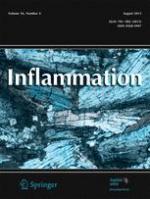Citation:
Lahav M, Ne'eman N, Sela MN, Ginsburg I. Effect of leukocyte hydrolases on bacteria. XIII. Inflammation. 1979;3 (4) :365-377.

Abstract:
Effect of leukocyte hydrolases on bacteria. XIII. Role played by leukocyte extracts, lysolecithin, phospholipase a2, lysozyme, cationic proteins, and detergents in the solubilization of lipids from Staphylococcus aureus and group A streptococci: relation to bactericidal and bacteriolytic reactions in inflammatory sites The bactericidal and bacteriolytic effects of lysolecithin (LL) and egg-white lysozyme (LYZ) on Staph. aureus and group A streptococci and the solubilization of phospholipids from the bacterial membranes by these agents was studied. Low concentrations of lysolecithin (1--10 microgrames/ml) are highly bactericidal for Steph. aureus and group A streptococci, but induce neither bacteriolysis nor solubilization of a substantial amount of membrane phospholipids. On the other hand, while LL at greater than 50 micrograms/ml causes substantial lipid release, a combination of LL and LYZ is absolutely needed to solubilize lipids from streptococci. This combination is, however, not bacteriolytic for this microrganism. The solubilization of lipids from staphylococci by LL is much faster than that induced in streptococci by LL + LYZ. The solubilization of the bulk of membrane lipids from staphylococci can also be achieved by Triton X-100 and by sodium lauryl sulfate and from group A streptococci by Triton X-100 plus LYZ. A variety of other detergents (e.g., Cetavlon, sodium taurocholate, cetyl pyrdinium chloride) have no lipid-releasing properties even in the presence of LYZ. The release of lipids by LYZ (in the presence of LL) from group A streptococci is related to its enzymatic activity, on a still unknown substrate, but not to its cationic nature as this muramidase cannot be replaced by a variety of cation substances (histone, polylysin, leukocyte cationic proteins, polymyxin B, and spermidine). The release of lipids from staphylococci by LL is not inhibited by a variety of anionic and cationic polyelectrocytes (heparin, liquoid, chondroitin sulfate, DNA histone, and polylysine) which markedly inhibit the release of lipids from group A streptococci by LL and LYZ. Streptococci that had been cultivated in the presence of subinhibitory concentrations of penicillin G lose their membrane phospholipids to a larger extent and by much smaller concentrations of LL and LYZ, as compared to controls, suggesting that the interference with the synthesis of the peptidoglycan increases the accessibility of the cell membrane to the lipid-releasing agents. The mechanism by which LL collaborates with LYZ in lipid release is still not known. The possible role of bacterial lipids and lyso compounds in the control of bacterial survival in inflammatory sites is briefly discussed.Publication Global ID: http://www.ncbi.nlm.nih.gov/pubmed/229078

